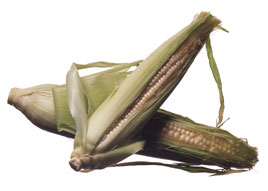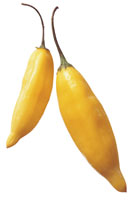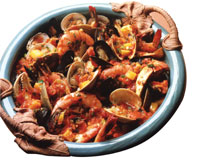
The Caribbean has an exotic quality that long has struck consumers as both friendly and a bit mysterious. The mystery may be over, however. Caribbean tourism has climbed 4% per year on average, introducing millions to island dishes. Ocean cruises have added exposure, while television's proselytizers of the culinary arts, including Emeril Lagasse, have introduced millions more to Caribbean cooking, paving the way to island inspiration in restaurants throughout North America.
Darden Restaurants' (Orlando) expansion of its Bahama Breeze concept across the U.S. reflects the growing popularity of the island eating adventure. Launched in 1996, the chain already has multiplied to 32 restaurants.
With this expanding Caribbean craze, grand opportunity awaits processors who can capture the color, tastes and excitement of this multi-faceted cuisine. In fact, retail sales of Caribbean-inspired foods already are climbing. Estimates of sales of Caribbean prepared foods already top $400 million.

Diverse Delights of the Caribbean
As stepping stones to the New World, the islands of the Caribbean hosted traders from every land. That diverse settlement remains manifest in Caribbean cuisine today. Just beyond the reach of British rule, the islands harbored the most adventurous of entrepreneurs, including the infamous buccaneers whose colorful legends grew on the Caribbean's high seas playground and numerous islands.Native Carib people pioneered the use of chili peppers for hot, spicy flavoring. Neighboring Arawak people cultivated the use of aromatic leaves from banana, fig, orange and other trees in cooking, and developed a form of pit barbecue from which the increasingly popular “jerk” foods derive. Spanish settlement—greatest in the regions now known as Puerto Rico, the Dominican Republic and Cuba—brought the culinary contributions of cilantro, citrus and annatto. Creole cooking—which includes seafood stews, bouillabaisse, chives and liberal mixtures of herbs—derived from French settlements in Martinique and Guadaloupe, and the French-Spanish island of Haiti. Dutch traders from the Dutch East India Company brought Southeast Asian ingredients like soy sauce to the islands of Curacao and St. Maarten. Interestingly, the cuisines of the largely British-settled eastern islands of Trinidad and Barbados are known for their spicy heat, a trait better credited to the native peoples than the English.
And those are only a few of the contributions to the fascinating Caribbean culinary melting pot. The African slave trade also delivered yams, okra, plantains, breadfruit, pigeon peas and oxtail. Curry arrived—probably again through Dutch traders—from the East Indies.

What is Caribbean Cuisine?
One might expect such a broad spectrum of influences to make Caribbean cuisine a mere mishmash of styles and recipes. But, in truth, Caribbean cooking is distinctive, despite its sponge-like absorption of influences and ingredients and its diverse manifestations from island to island.Caribbean cuisine is a colorful mix of spicy, fun foods often drenched—literally—in island flavors. Meats are flavored with marinades and dry rubs and smoked in a closed pit environment to deliver jerked food delight. Hot pepper sauces, fruit-based sauces, and chiles soak foods in flavor. Soups and stews—pepperpot, quimbomba, sopito, conch chowder, bebele and more—are abundant and diverse favorites on island menus. The typical recipe revolves around meats and seafood mixed with spices, peppers, vegetables and potatoes or other tubers. Chayote is a versatile gourd vegetable that works its way into many of these tasty meals. Seasoned rice and legumes are ever-present staples.
Generally speaking, Caribbean cuisine incorporates vegetables, fruits and spices commonly spread among the isles. Lima beans, black-eyed peas, corn, yams, sweet potatoes, cassava and taro root are indigenous to the islands and, thus, are liberally added to the Caribbean meal. Other foods native to the islands include manioc, corn, peanuts, hog plums, mamee apples and star apples. Native fruits include guava and pineapple.
The islands also are famous for hot peppers (principally habaneros or Scotch bonnet peppers, the latter most common in Jamaica), the ubiquitous rice and beans, and nutritious starch cassava. Sauces are frequently mixes of heat and fruit. Fruit juices lead the beverage list, with rum a common accompaniment. Coconut makes frequent contributions in both fresh dishes and as an ingredient and sauce additive.
Rice in a variety of forms complements main dish proteins. Its receptivity to seasonings and ingredients like curry, cilantro, soy sauce and ginger enables it to deliver a variety of Caribbean tastes. Often accompanied by black beans or black-eyed peas, it also provides a base for colorful mixes of sauces, fruits, vegetables and seafood.
Beans are used in whole and ground form in countless recipes. Black beans accompany rice, salads and stews. Gandules, or pigeon peas, add a different texture and full flavor.
The sweet potato-like boniato is another popular starch found in many Caribbean dishes, as is breadfruit, a versatile starch that can be served by itself in baked or grilled form or added to stews and soups.

Spice Parade
The Caribbean chef has enormous palettes of colors and flavors to choose from as he whips up island recipes. Marinades and sauces may employ garlic, clove and any number of herbs, including lemongrass, cilantro and bay leaf. Native allspice and annatto lead the spice lineup, followed by thyme, clove, ground mustard and cinnamon. Of course, there is nutmeg. The tiny island of Grenada (21 miles by 12 miles in dimension) is the second largest nutmeg exporter in the world.Wide families of hot peppers give Caribbean sauces their trademark zing. Scotch bonnet peppers and habaneros are the best known of the hot peppers, but pimientos and Jamaican varieties see plenty of play as well. Many pepper-based sauces are mixed with aromatic fruit—citrus or peach, for example—or papaya, mango or tomato. Adobo seasoning, a peppery blend of oregano and garlic, is used with citrus marinades.
Coconut makes many appearances in island meals—from milk-like beverages to refreshing snacks. The coconut milk also moderates the heat of hot, spicy foods and serves as a base for stews, soups and sauces.
Creative Caribbean Twists
Turn-of-the-century Nuevo Latino food trends set the stage for the current tide in Caribbean cooking. But restaurateurs and chefs often opt for liberal twists on Caribbean themes in lieu of authentic island recipes.Steve Harris, manager of Watusi, a Caribbean-style Chicago eatery, describes his restaurant's offerings as “contemporary American with Caribbean flair.” His menu includes conch fritters (a mix of conch and corn meal) with a hot habaneros dipping sauce; steamed mussels cooked in white wine broth with chili peppers; and pulled pork from a slow-roasted suckling pig served with fluffy white rice spiced with coconut and ginger. “Our black beans are mixed with tequila and olive oil,” says Harris. “That's the Watusi twist.”
“A lot of chefs are taking the recipes from these countries and putting their own twists on them,” confirms Chris Bupp, general manager of the Mambo Grill, another Caribbean/Latin American Chicago restaurant. Cuban culinary inspiration is evident in Guava Glazed Paella and Marinated Roasted Chicken with a Guava Glaze. Other twists include twice-baked Boniato au Gratin, and Roasted Pork Tenderloin with Roasted Red Onion, Sweet Potato and Boniato.
Bupp's menu inspirations from the Dominican Republic include Bombas de Camarones—baking potatoes made into mashed potatoes with added chipotle peppers and cilantro and stuffed with shrimp—and Fricassee de Pollo, a stewed chicken breast served with onion, peppers, bacon and carrots.
Jamaican Jerk Pork is a signature item of the Bahama Breeze restaurant chain. The slow-cooked, tender pulled pork, served with a jerk sauce comprised of scallions, thyme and a mix of island seasonings, typifies the flavorful island approach to meat preparation. Such products point the way to profit for enterprising processors.
The “jerk” approach to other proteins holds infinite possibilities. Jerk chicken, jerk fish and jerk shrimp have flavorful appeal to growing numbers of Caribbean restaurant patrons. “We serve a jerk turkey that is very unique and flavorful, and an oxtail that falls off the bone,” says Owen Daley, proprietor of Daddy-O's Jerk Pit in Chicago.

Goya Grows as Result of Interest
Among North American processors, Goya Foods (Secaucus, N.J.), specialists in prepared foods from the region, seems to be best positioned to capitalize on the Caribbean craze. Its core products include black beans and other dry and canned legumes; island-flavored rice mixes, including curry rice and rice and bean blends; canned, bottled and dry beverages; and a wide assortment of seasonings, marinades and cooking oils. Recently, however, it has expanded its lines of prepared frozen products to close to 100 SKUs and expanded its dry rice mix lines, too, according to spokesman Ralph Toro.With facilities in Puerto Rico, the Dominican Republic, Spain and eight locations in the U.S., it long has provided characteristic Caribbean products to those brought up on island cuisine. Now it faces the possibility of serving a much broader consumer base.
“We are designing products specifically for people who want to try (Caribbean) food but do not know how to cook it,” says Toro. Products offered include empanadas, rice with chicken and rice with beef stew items. “A good part of our growth is due to non-Hispanic consumers wanting to try these products.”
A conspicuous opening exists for frozen or refrigerated fresh island dishes—particularly meat- and seafood-based items. With consumers developing a passion for hot island favorites, American processors would do well to explore the Caribbean's culinary potential.
Website Resources
www.unichef.com/caribgloss.htm— A glossary of Caribbean spices and ingredientswww.caribcon.com— An extensive list of Caribbean recipes
www.afiwi.com/dates.asp— Learn about Caribbean history with this comprehensive calendar
www.caribbeanfoodemporium.co.uk— Information regarding typical Caribbean foods and drinks, and history